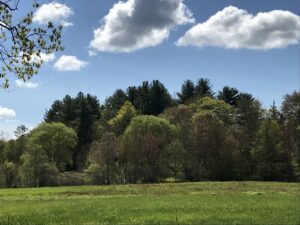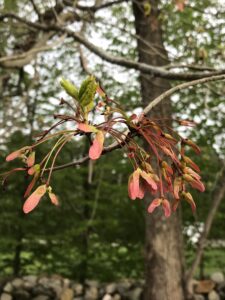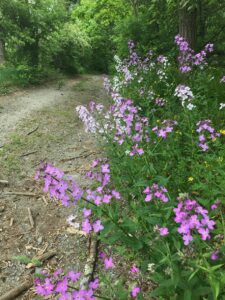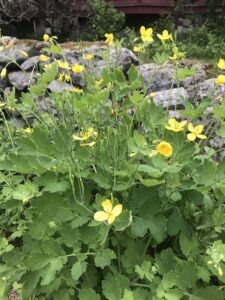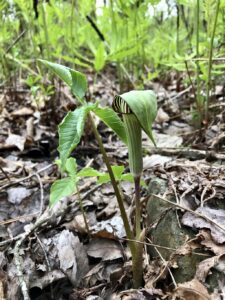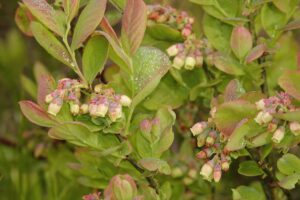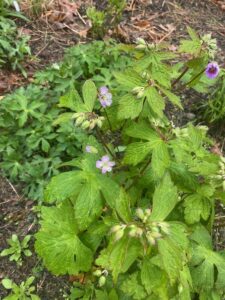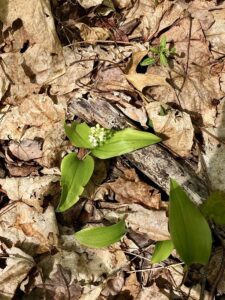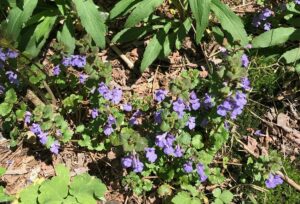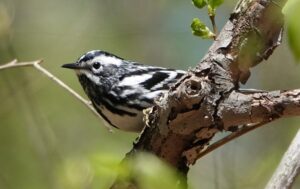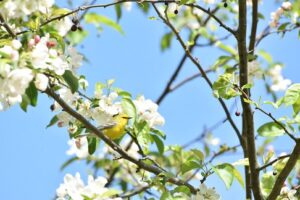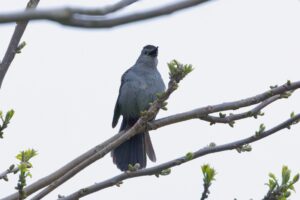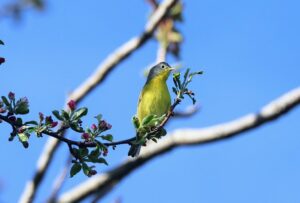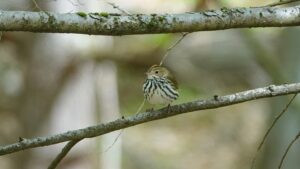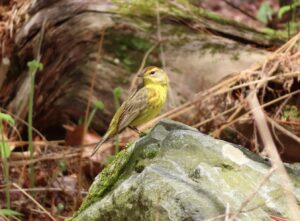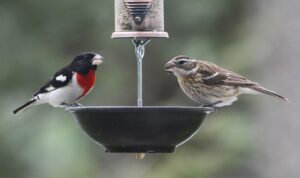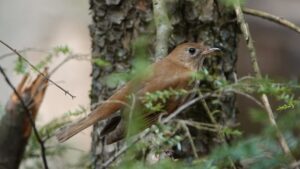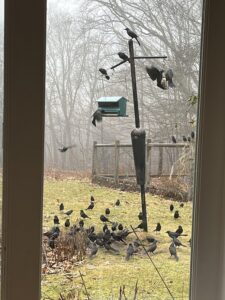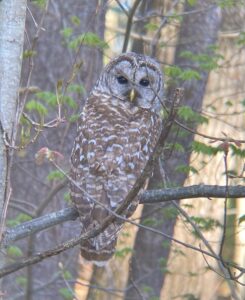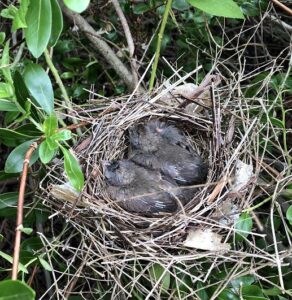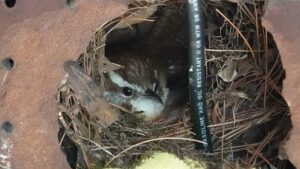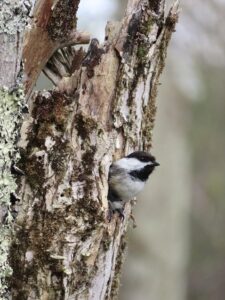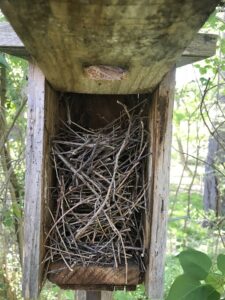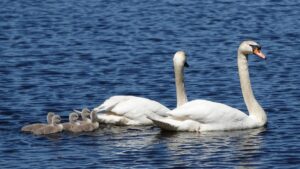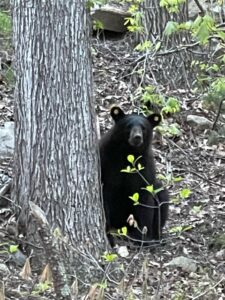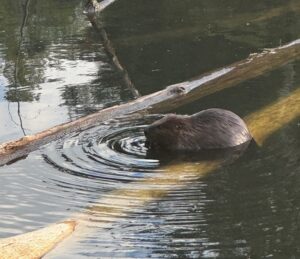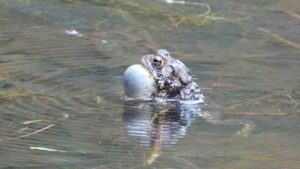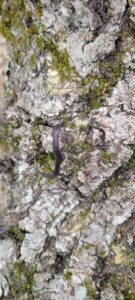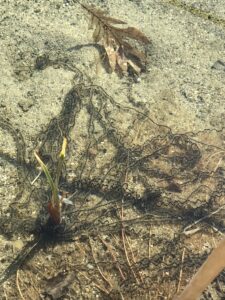Written by Gwyn Loud for the Lincoln Land Conservation Trust. She welcomes your sightings and questions at 781-259-8690 or gwynloud555@gmail.com
April showers did indeed bring May flowers, and the showers have continued. Boston has had 6.06 inches more rain than average so far this year. Some nights and early mornings have been chilly; there was ice on my bird bath on April 25 and the winter jackets are still handy. Despite what we experienced with local weather, April marked the 11th consecutive month of record global heat. At this point NOAA’s Climate Prediction Center is expecting the 2024 summer to be one of the hottest on record in New England.
Most deciduous trees have leafed out by now, with oaks and black locusts last to join the parade. The landscape is painted in bright spring green, with oaks a light yellow-green, and a brush of red from maple samaras or young oak leaves. Poison ivy leaves are also shiny and reddish while they are just opening at this time of year. Pollen season is beginning, as those with allergies know well. Most of our conifers and trees such as oaks and birches are pollinated by wind rather than insects.
One can see white signs on many roadside trees, indicating they are slated to be cut down by EverSource. An arborist for EverSource, Matthew Mitchell, wrote an article for The Lincoln Squirrel explaining why the trees were selected (see link below) and there will be a public hearing about it on May 22 at the DPW office. Some of the designated trees are ash trees, which have nearly all died due to damage from the emerald ash borer.
Shadbush has nearly finished blooming, but high and low-bush blueberries are flowering and plants such as greater celandine, Dame’s rocket, and pussy-toes are flowering along roadsides. In the woods look for flowers such as star flower, wood anemone, or jack-in-the-pulpit, and soon the Canada mayflowers will be fully in flower, carpeting the forest floor. Within a couple of weeks watch for the beautiful lady’s slippers. Around houses dogwoods have had a spectacular flowering season, and lilacs are robust as well. Garlic mustard is flowering and should be pulled before it goes to seed.
Those who are participating in the “No Mow May” approach to lawns are letting the grass grow longer to allow a variety of small flowers to bloom in the grass, a boon for pollinators and the health of the ecosystem. In the un-mowed portion of my lawn I am seeing tiny insects visiting flowers such as buttercups, dandelions, violets, cinquefoil, thyme-leaved speedwell, and ground ivy.
In an article about “Rethinking the Lawn”, Tim Traver wrote in The Outside Story, “Some 50 million acres of the American landscape is covered by lawn, and Americans spend an estimated $100 billion or more each year on lawn care. Yes, there’s beauty in these manicured spaces. But there’s also significant environmental cost in this age of climate four alarm bells. In recent decades – citing the use of fossil fuels, water use, the damaging runoff of fertilizers, and the detriment of insecticides – many have begun to rethink the mighty lawn.”
Many migrating birds have arrived over the past month, including some of the most colorful, such as Baltimore orioles, rose-breasted grosbeaks, indigo buntings and scarlet tanagers. Other recent arrivals include gray catbirds, vireos, and thrushes such as veery, Swainson’s, and wood. A few bobolinks have been seen at Drumlin Farm and we hope to see them soon at Farm Meadow. Great-crested flycatchers can be heard giving their nasal ascending “wheeeeep” call high in the canopy. Wood warblers are favorites among birders, and on a recent walk at Minuteman National Historic Park nineteen species of warblers were seen! Many will go farther north to breed, but species such as yellow warblers, pine warblers, ovenbirds, and common yellow-throats will raise families here. Ruby-throated hummingbirds turned up on May 1 at my sugar-water feeder and will be busy here all summer, caring for 1-3 young in a tiny nest, “made of thistle or dandelion down, held together with strands of spider silk and sometimes pine resin. The female stamps on the base of the nest to stiffen it, but the walls remain pliable, allowing it to stretch as the chicks grow. She shapes the rim of the nest by pressing and smoothing it between her neck and chest. The exterior of the nest is decorated (probably camouflaged) with bits of lichen and moss”, to quote All About Birds.
May is all about nesting and first broods of birds such as Eastern bluebirds have already hatched. Baby birds in the nest can only swallow soft food such as caterpillars, a good reason to welcome insects to our gardens. “A single pair of breeding chickadees must find 6,000 to 9,000 caterpillars to rear one clutch of young”, according to Doug Tallamy, a professor of entomology and wildlife ecology at the University of Delaware. Barn swallows are back in my neighbor’s barn, another neighbor had Carolina wrens nesting, as they did last year, on top of a propane tank, and a third neighbor has an Eastern Phoebe nesting under the eaves. Residents on Beaver Pond Rd. have a pair of red-tailed hawks raising young for the fifth year in the same nest (repaired annually) high in a white pine. Red-shouldered hawks are calling frequently along Conant Road, surely nesting in the woods nearby. Black-capped chickadees dart in and out of small tree cavities to feed their young. On Farrar Pond a pair of mute swans had seven cygnets, and Carol Roede videoed a large family of wood ducks on the pond behind her house. Wood ducks nest in tree cavities (some use man-made bird boxes) and several females may lay eggs in the nest, leading to as many as forty eggs! The little downy babies leap to the ground from their high tree hole, then follow their mother on a precarious journey to the nearest pond, which may not actually be very near.
Our local mammals are also busy raising young. The speaker at recent LLCT program about coyotes explained that the pups are born in a den in April-May and the male stands guard, so this is a time when dog walkers should have dogs leashed if they are near possible dens. Observers at Drumlin Farm saw a coyote carrying a rabbit on the west side of the drumlin. The chipmunk population has grown on my property, and the woodchuck is back, keeping an eye on his growing restaurant (aka my vegetable garden). Probably the most exciting mammal report is of a black bear, caught on a security camera before dawn on May 9, taking down a bird feeder on Rockwood Lane (near Tracey’s and the Birches School). It was seen on subsequent days in other parts of town, including along Codman Road by CCF, and on the night of May 14 behind houses along Farrar Pond across from Mt. Misery. Its ears are tagged and it appears to be a young bear. It is well known that young males, after spending their first year with mom, have to venture out to establish new territories. Bears are more common in the western part of Mass. and it is no surprise that they are exploring to the east. Bears are tagged by wildlife biologists to monitor their populations and distribution, and to allow recognition of individuals. “Our” bear was tagged by MassWildlife and moved out of a developed area in Worcester. It found its own way to Lincoln. For more information about bears see link below.
Other mammals seen include a long-tailed weasel in a barn at Drumlin, a mink near a stream on Old Conant Road, and raccoons and rabbits in several places. Carol Roede’s trail cam captured photos of a coyote pair, a bobcat (sometimes refreshing his scent marking), and an opossum.
Wood frog tadpoles are getting big and will be growing legs soon, ready to become adults and head for dry land. American toads could be heard trilling recently and by now have laid their eggs in long strands, looking like black pearl necklaces. The tadpoles are jet black, easy to distinguish from other tadpoles. Gray tree frogs have also been calling and you might even find one using its little sticky-pad toes to cling to the outside of a window. Red-backed salamanders are very common- try gently rolling over a rotten log and you might discover one. Be sure to roll the log back! If you are lucky you may find a red eft, the juvenile form of the Eastern red-spotted newt.
In the world of reptiles, garter snakes have been seen by many observers, and painted turtles are enjoying sunning on logs near ponds. More about turtles next month.
If you have seen a bumblebee hovering close to the ground, that would be a queen looking for a nest hole such as an old rodent burrow, where she can start her new colony. A post from PennState Extension explains, ‘“But before a queen can lay eggs, she must forage for pollen and nectar as a source for proteins and carbohydrates. These macromolecules play an important role in the activation of her ovaries and initiation of egg-laying.”
Numerous insects are emerging as warm weather arrives and it behooves us all to protect them, as they are crucial to our ecosystems and food chains. Many people are growing flowers to attract pollinators, and Rich Rosenbaum sent a photo of a house he set up to attract mason bees. Butterflies are appearing; so far I have seen cabbage whites, a tiger swallowtail, and a red admiral. Red admirals are migratory, going from New England to southern states for the winter, where a new generation is born, sending adults back to us at this time of year.
Looking skyward, we can enjoy the Full Flower Moon on May 23. On May 11 and 12 many people in New England and even into the southern USA were treated to views of the spectacular northern lights, caused by explosions of plasma and magnetic material shooting out of the sun. The sun has an 11 year cycle and its maximum stormy activity, “solar maximum” will fall somewhere between Nov. 2024 and March 2026, so hopefully we will have another chance to see the northern lights from Lincoln.
Links


